|
|
|
Sort Order |
|
|
|
Items / Page
|
|
|
|
|
|
|
| Srl | Item |
| 1 |
ID:
117934
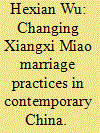

|
|
|
|
|
| Publication |
2013.
|
| Summary/Abstract |
This essay describes elements of Xiangxi Miao marriage practices such as courtship, wedding ceremonies, and marriages between the Miao and Han, exploring how Xiangxi Miao marriage practices changed at the turn of this century, and disclosing social influences on the changes in marriage practices. The author uses a Miao village of Zalun as a case study. Through participant observation and intensive interviews, it was found that, before 2000, Xiangxi Miaos' courtship practices and wedding ceremonies had strict processes and reflected agricultural rhythm. In addition, there were few marriages between the Miao and Han. Since the beginning of this century, Xiangxi Miao marriage practices have changed due to socioeconomic development, population mobility, and diverse communication between Miao young women and men. Dramatic shifts in marriage practices have produced social influences among Xiangxi Miao communities. The changes in marriage practices have promoted Xiangxi Miao free marriages, advancing social cohesion and acculturation. However, these changes have also increased numbers of criminals and problems of healthy growth and education of the stay-at-home children.
|
|
|
|
|
|
|
|
|
|
|
|
|
|
|
|
| 2 |
ID:
099700
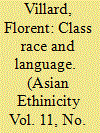

|
|
|
|
|
| Publication |
2010.
|
| Summary/Abstract |
This study investigates the discursive peregrinations of the 'Han' category in the writings of the Chinese revolutionary, theoretician and activist Qu Qiubai. In the papers he wrote at the beginning of the 1930s dealing with the questions of language and writing, the author made singular use of the concept 'Han' to talk about the language/writing of the 'Han' (Hanzi, Hanyu) as a racial or ethnic group (Hanzu). Qu elaborated a discourse which articulated and mobilized, sometimes in a contradictory manner, the 'Han' category both as a 'race' and as a social class. Going beyond the race/class dialectic, I will try to show that these texts question the territorial, cultural and ethnic boundaries of 'China' and its homogeneity. Following this argument, this paper demonstrates how Qu's attempt to define 'Chinese language(s)' helps us to elucidate the complex articulation between China as a discursive and spatial category, the 'Han' category, and the other nationalities in the Chinese space. By questioning the homogeneity of the linguistic identity of China, using the word zhongguohua, Qu Qiubai unveiled an unstable and fragile imaginary relative to China and its so-called majority ethnic group, the Han.
|
|
|
|
|
|
|
|
|
|
|
|
|
|
|
|
| 3 |
ID:
147871
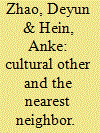

|
|
|
|
|
| Summary/Abstract |
Greater Liangshan is one of the few regions of China where, among 70–80% of Nuosu, the Han are a minority. Instead of the much more common phenomenon of ‘Hanification,’ here we can observe Han absorbing traits of other ethnic groups. Based on two seasons of fieldwork combined with historical texts and previous ethnographic research, this paper discusses this phenomenon, raising issues of ethnic identity and the influence of local circumstances on interethnic relations. Throughout the paper, it becomes clear that there is no simple dichotomy between Han and Nuosu, but that the situation is considerably more complex. The Nuosu fall into several castes, and the Han settlers had two different experiences. Some were captured as slaves and tried to become fully Nuosu. Ethnic relations in the Greater Liangshan are thus highly complex and require more research to be thoroughly understood.
|
|
|
|
|
|
|
|
|
|
|
|
|
|
|
|
| 4 |
ID:
139540
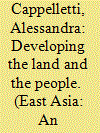

|
|
|
|
|
| Summary/Abstract |
Social development in Xinjiang Uyghur Autonomous Region from 1999 to 2009 is the focus of this article. I will explore the current situation among Uyghurs and Hans living in Xinjiang in different social contexts and purviews, mainly assessing problems and open questions hindering a balanced and consensus-based social development in the area. The concept of “development” per se will be understood with a critical perspective. The fieldwork was conducted in 2011 and 2012 in Urumqi, Turpan, Kahsgar, Wujiaqu and Shihezi, and in eight rural villages—seven located in the Kashgar Prefecture and one in Kizilsu Kyrgyz Autonomous Prefecture. The opportunity to adopt an “insider perspective”, at the same time working with critical tools provided by the disciplines of sociology and anthropology, can be considered an important asset in the field of Xinjiang studies. My PhD research in China (2010–2013) and my work as consultant for KFW (2011–2012) have been of great help in adopting this approach. Interviews, participant observation and analysis of quantitative and qualitative data from different sources are the basis of the fieldwork results presented here. UNDP indicators and indexes are taken as reference in setting and organising data.
|
|
|
|
|
|
|
|
|
|
|
|
|
|
|
|
| 5 |
ID:
103139
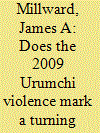

|
|
|
|
|
| Publication |
2009.
|
| Summary/Abstract |
To provide background for the four papers on Xinjiang and the Uyghurs in this special issue, this introduction discusses developments in the region since 1991, then outlines the events of June and July 2009 in Shaoguan, Guangdong, and Urumchi, Xinjiang, as best can be pieced together from available information. It concludes with brief introductions to the four articles on Xinjiang that follow in this special issue.
|
|
|
|
|
|
|
|
|
|
|
|
|
|
|
|
| 6 |
ID:
190413
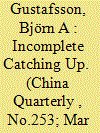

|
|
|
|
|
| Summary/Abstract |
This paper explores household income per capita for the rural Yi and Manchu ethnic minority groups and the Han majority using data from the China Household Income Project 2002, 2013 and 2018. The disparity between total per capita income for the Yi and Han populations narrowed, while the average per capita income for the Manchu population remained relatively similar to that of the Han population. Decomposing total income to its sources shows that the rapid increase in agricultural income among the Yi was a main reason why the disparity in income, compared to the two other ethnic groups, narrowed. Nevertheless, reliance on agricultural income among the Yi was reduced as wage employment and migration increased. The Manchu group and the Han group also experienced rapid increases in wages and self-employment income. The aggregated value of transfers from the public sector was similar for all three ethnic groups.
|
|
|
|
|
|
|
|
|
|
|
|
|
|
|
|
| 7 |
ID:
173850
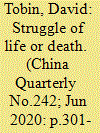

|
|
|
|
|
| Summary/Abstract |
In July 2009, nearly 200 people were killed in ethnically targeted mass violence between Turkic-speaking Muslim Uyghurs and Han Chinese in Urumqi, overshadowing the 60th anniversary of the founding of the People's Republic of China (PRC). How have ethnic relations between Han and Uyghurs descended into mass violence among ordinary people? This paper argues that the party-state exacerbates ethnic tensions between Han and Uyghurs through ethnocentric security narratives. These narratives frame China's identity as being under threat from Turkic enemies within who are supported by Islamic terrorists and Western “enemies of China” from outside. Discourse analysis of official texts, participant-observation of security practices, and interviews with Han and Uyghurs reveal the interplay between official identity discourses and everyday security practices before, during and after the violence. Since July 2009, one official solution to ethnic violence has been the construction of a shared multi-ethnic identity, officially described as a “zero-sum political struggle of life or death.” However, Han-centric conceptualizations of ethnic unity promote Han chauvinism and portray the Uyghur as a security threat. The party-state thus creates hierarchical ethnic relations that exacerbate both Han and Uyghur insecurities and contribute to spirals of violence. China's extra-judicial internment camps in Xinjiang are the logical conclusions of the ethnocentric insecurity cycles analysed in this article.
|
|
|
|
|
|
|
|
|
|
|
|
|
|
|
|
| 8 |
ID:
115435
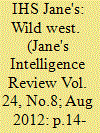

|
|
|
| 9 |
ID:
110011
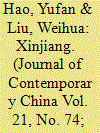

|
|
|
|
|
| Publication |
2012.
|
| Summary/Abstract |
The 5 July event in Urumqi inspired rethinking about Beijing's policy towards Xinjiang. This paper will examine Beijing's interests in Xinjiang from historical, political, economic and security perspectives, and the challenges Beijing faces in pursuing and protecting its interests. By examining the tensions between the Han and ethnic minorities, especially the Uyghurs in Xinjiang, the paper argues that the Xinjiang issue involves China's core interests and the most serious challenge Beijing faces is how to cope with ethnic tension in a highly sensitive region surrounded by big powers.
|
|
|
|
|
|
|
|
|
|
|
|
|
|
|
|
| 10 |
ID:
141157
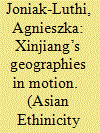

|
|
|
|
|
| Summary/Abstract |
At the same time it asserts that Uyghur and Han do not establish distinct spatial relationships just because of their ethnicity, but also to enhance ethnic solidarity and boundaries vis-à-vis the other. This essay also demonstrates that places are historically contingent, and discusses the ways in which the influx of temporary Han migrants and settlers – and Han capital – has generated new layers of spatial meaning and new power differentials.
|
|
|
|
|
|
|
|
|
|
|
|
|
|
|
|
|
|
|
|
|